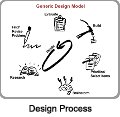|
Professional Development
Planner
In the end, teacher professional development, like all
learning, is done in small steps. No single lecture, movie,
or paper can lead to meaningful change. Like your students,
you need to construct your learning over a period of time
for it to have any chance of lasting.
The Professional Development Planner table below has assembled
a collection of movies and articles that can be the subject
of your own long-term investigations and teaching experiments.
It offers a research-supported path to becoming a better
teacher. Click on the thumbnail pictures to go to the
relevant DITC pages, or the Acrobat icon to read and print
out the related document.
| Title/Paper |
Movies |
Description |
|
Exploring Formative Assessment
 "Inside The Black Box" (14 pages) "Inside The Black Box" (14 pages)
|

Powerful Research
|
Some of the best educational research says that formative
assessment improves students' learning. As a teacher,
you need to find out on your own how to make these
strategies work to you. Listen to Paul Black talk
about his pamphlet, Inside The Black Box,
and then plan your own experiments with this key
to effective pedagogy.
|
|
Learning About the Design Process
|

Generic Design Process Model |
DITC only scratches the surface of the kind of training
that leads do internalizing the many strategies
related to the design process. A good introduction
to the design culture with its own language and
ways of acting takes years and outside the range
of DITC, but you can get a flavor for this parallel
to inquiry by reviewing the Learn About
Design section, especially the first three
topics in its the purple navigation bar.
|
|
Developing Kids' Awareness of Designer Roles and Strategies
|

Hotspots Revealed

Teaching Experiment
|
Assessing
what strategies your youthful designers use requires
background knowledge about design strategies and
practices. The "Hotspot Revealed" movie can be
used with your own students to provide them with
the info they need to be able to evaluate kids
their own age doing tasks they have already completed.
In "Teaching Experiment" you can see science
teacher Toni Laman getting students to develop
their own way of describing design strategies.
She then leads her students through reflects of
their own work in groups and strategies they used.
Building such "metacognitive awareness" was a
major goal she had for her students.
|
|
Encouraging Creativity in Kids
|

Encouraging Creativity
|
Strategies
that you use with groups of students can either
foster or squelch creativity. David Perkins of
Harvard's Graduate School of Education discusses
how creativity is not for the elite few, but is
made up of thinking strategies that are available
to most everyone. Richard Kimbell and Woodie Flowers
both talk about ways they have found to support
students "thinking outside the box."
|
|
What Is a Good Design Challenge?
|

Good Design Challenge
|
If you talk to teachers who use design tasks over a
period of years, you can always engage in a lively
debate about what makes for a good design challenge.
Tech ed and science teachers have very different
answers to this question and related questions.
How open-ended should the original challenge be?
Do design challenges that converge on a single
"optimal" solution violate the spirit of exploring
a design challenge? Key features of good design
tasks are discussed.
|
|
What's Hard About a Topic?
 "The Many Faces of Constuctivism" (6 pages) "The Many Faces of Constuctivism" (6 pages)
|

What's Hard About A Topic
|
The Learning
Sciences show that instruction that ignores students'
preconceptions often ends up not changing them.
Harvard's David Perkins discussed a key topic
that helps focus your attention on the key difficulties
that students may encounter as you plan a lesson.
Asking the question, "What's hard for students
about this topic?" can place this issue in
the forefront of your lesson planning for the
benefit of all.
|
|